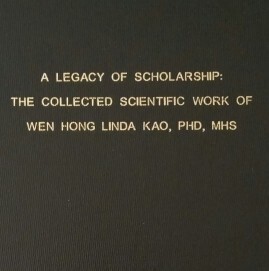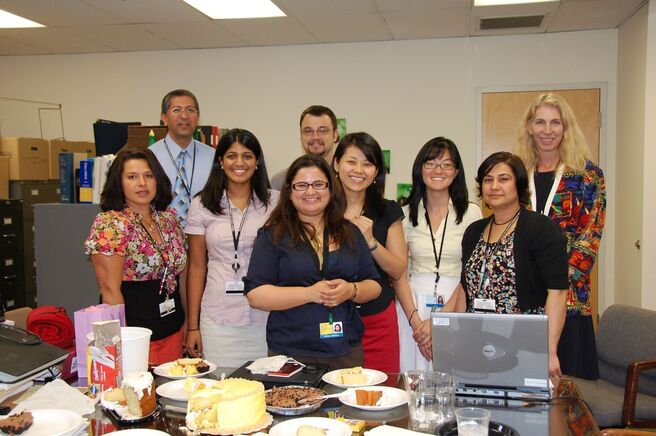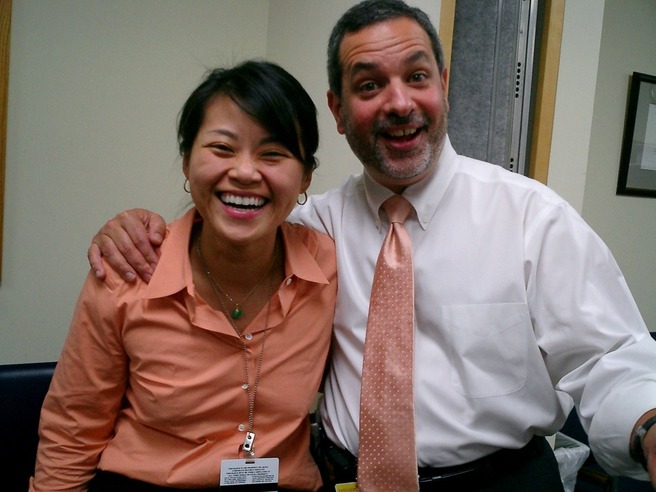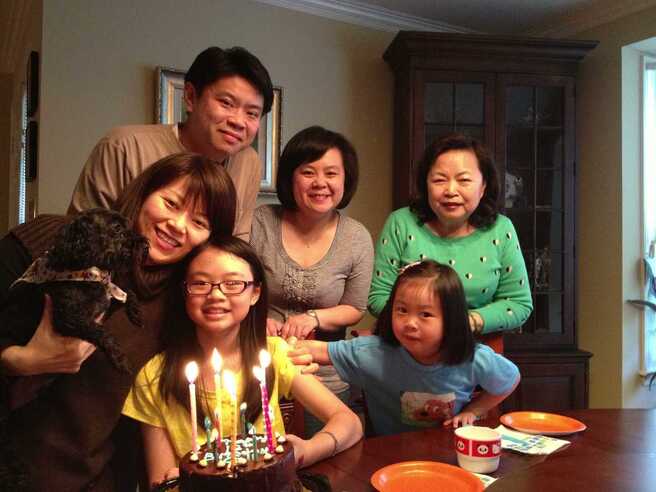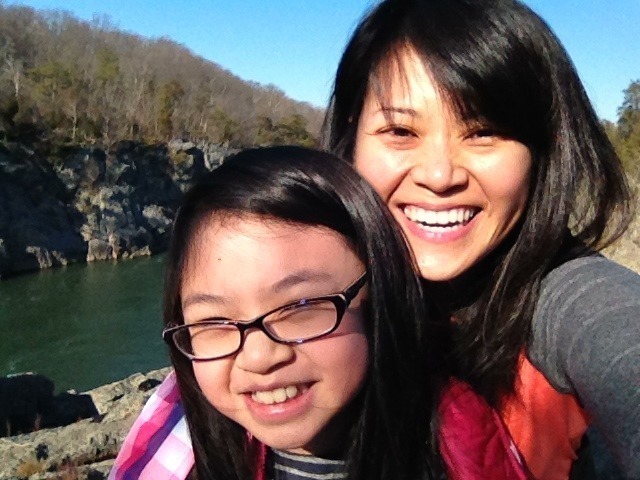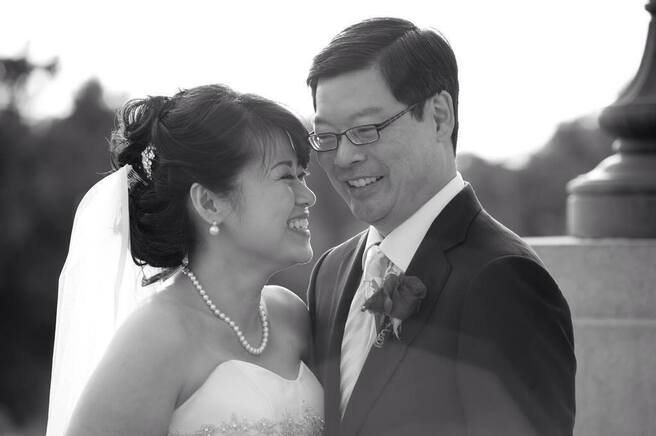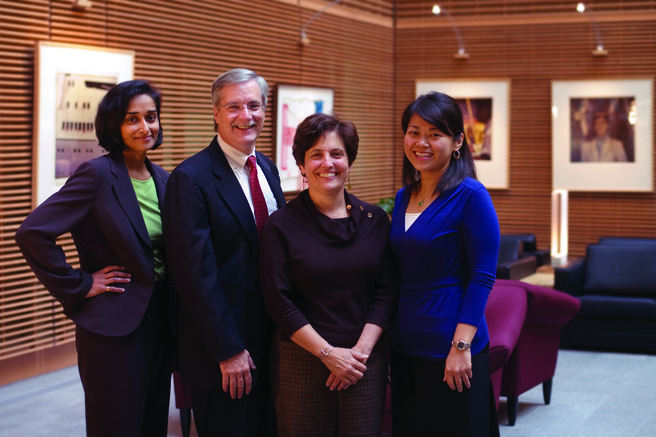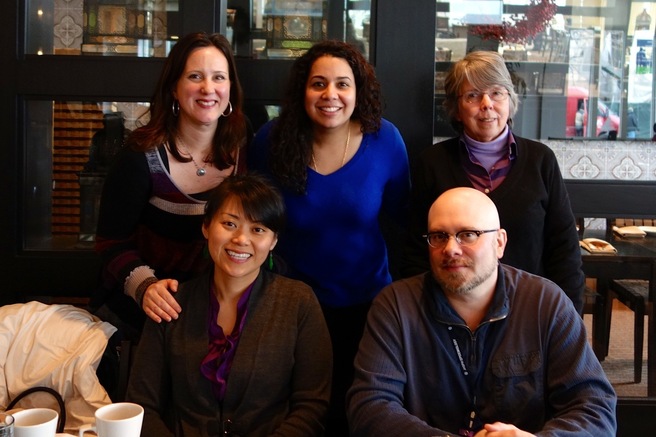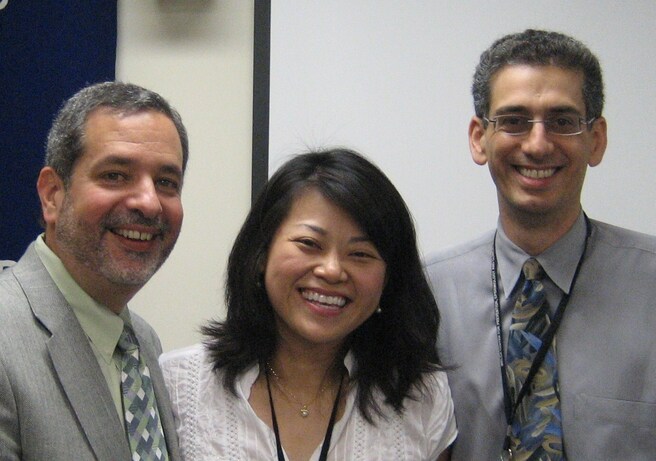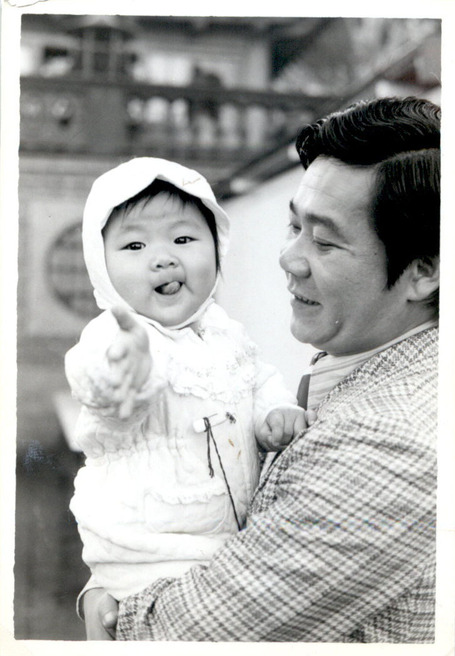Scientific Legacy
In Her Lifetime
As memorialized in the pictured collection containing more than 1,500 pages of her published work, Linda was a prolific scientist. First, she considered herself an epidemiologist, and early in her career, she studied the epidemiology of diabetes and related conditions. During her early years on faculty at Johns Hopkins, she cemented her place in genetic epidemiology. She worked with Dr. Frederick Brancati to spearhead the work on the genetics of type 2 diabetes in the Atherosclerosis Risk in Communities Study; this work contributed to the involvement of the ARIC cohort in multiple genetics consortia that still produce the cutting edge work in the the genetics of metabolic disease.
Simultaneously, she was a pioneer in demonstrating the value of admixture mapping for understanding the genetic causes of end-stage renal disease and other diseases. Her later work focused on the genetics of chronic kidney disease using genome-wide approaches - best demonstrated by her co-leadership of the CKDGen Consortium.
The PACE Study was especially dear to her as she never lost sight of the importance of improving the lives of others in her work. In the last years of her life, she devoted substantial time to the scientific questions that could be asked about patients undergoing dialysis, including those of quality of life.
During her lifetime, Linda had >180 publications; she mentored over 20 students in Epidemiology and the MPH program at Johns Hopkins, including 10 PhD students; had numerous mentees in the School of Medicine; and received 10 external grants as a Principal Investigator.
Posthumous Legacy
Since Linda passed away on June 15, 2014, her mentees have had continued success, and her work continues to appear in the peer-reviewed literature.
Mentees
The work of her mentees will be the largest part of her enduring scientific legacy. Her last PhD students, Mandy Li and Poojitha Balakrishnan, completed their PhDs at Johns Hopkins in May 2015 and are now in post-doctoral fellowships. Dr. Adrienne Tin has joined the faculty of The Johns Hopkins University Bloomberg School of Public Health.
Publications
Since her passing, Linda's work has appeared in 38 additional publications (as of June 15, 2016) with more in progress.
Genetic discovery in community-based cohort studies
Genetic variants in RBFOX3 are associated with sleep latency. Eur J Hum Genet. 2016 May 4. [Epub ahead of print]
Tin A, Balakrishnan P, Beaty TH, Boerwinkle E, Hoogeveen RC, Young JH, Kao WH. GCKR and PPP1R3B identified as genome-wide significant loci for plasma lactate: the Atherosclerosis Risk in Communities (ARIC) study. Diabet Med. 2015 Oct 3. [Epub ahead of print]
Maruthur NM, Li M, Halushka MK, Astor BC, Pankow JS, Boerwinkle E, Coresh J, Selvin E, Kao WH. Genetics of Plasma Soluble Receptor for Advanced Glycation End-Products and Cardiovascular Outcomes in a Community-based Population: Results from the Atherosclerosis Risk in Communities Study. PLoS One. 2015 Jun 17;10(6):e0128452. eCollection 2015.
Tin A, Köttgen A, Folsom AR, Maruthur NM, Tajuddin SM, Nalls MA, Evans MK, Zonderman AB, Friedrich CA, Boerwinkle E, Coresh J, Kao WH. Genetic loci for serum magnesium among African-Americans and gene-environment interaction at MUC1 and TRPM6 in European-Americans: the Atherosclerosis Risk in Communities (ARIC) study. BMC Genet. 2015 May 29;16(1):56.
Musani SK, Fox ER, Kraja A, Bidulescu A, Lieb W, Lin H, Beecham A, Chen MH, Felix JF, Fox CS, Kao WH, Kardia SL, Liu CT, Nalls MA, Rundek T, Sacco RL, Smith J, Sun YV, Wilson G, Zhang Z, Mosley TH, Taylor HA, Vasan RS. Genome-wide association analysis of plasma B-type natriuretic peptide in blacks: the Jackson Heart Study. Circ Cardiovasc Genet. 2015 Feb;8(1):122-30. Epub 2015 Jan 5.
Tsai CW, North KE, Tin A, Haack K, Franceschini N, Saroja Voruganti V, Laston S, Zhang Y, Best LG, MacCluer JW, Beaty TH, Navas-Acien A, Kao WH, Howard BV. Both rare and common variants in PCSK9 influence plasma low-density lipoprotein cholesterol level in American Indians. J Clin Endocrinol Metab. 2015 Feb;100(2):E345-9. Epub 2014 Nov 20.
Epidemiology of chronic kidney disease
Tin A, Grams ME, Maruthur NM, Astor BC, Couper D, Mosley TH, Selvin E, Coresh J, Kao WH. Results from the Atherosclerosis Risk in Communities study suggest that low serum magnesium is associated with incident kidney disease.
Kidney Int. 2015 Apr;87(4):820-7. Epub 2014 Oct 1.
Grams ME, Li L, Greene TH, Tin A, Sang Y, Kao WH, Lipkowitz MS, Wright JT, Chang AR, Astor BC, Appel LJ. Estimating time to ESRD using kidney failure risk equations: results from the African American Study of Kidney Disease and Hypertension (AASK). Am J Kidney Dis. 2015 Mar;65(3):394-402. Epub 2014 Oct 14.
Grams ME, Matsushita K, Sang Y, Estrella MM, Foster MC, Tin A, Kao WH, Coresh J. Explaining the racial difference in AKI incidence. J Am Soc Nephrol. 2014 Aug;25(8):1834-41. Epub 2014 Apr 10.
Epidemiology of APOL1 genotype
Tin A, Grams ME, Estrella M, Lipkowitz M, Greene TH, Kao WH, Li L, Appel LJ. Patterns of Kidney Function Decline Associated with APOL1 Genotypes: Results from AASK. Clin J Am Soc Nephrol. 2016 May 26. [Epub ahead of print]
Chen TK, Choi MJ, Kao WH, Astor BC, Scialla JJ, Appel LJ, Li L, Lipkowitz MS, Wolf M, Parekh RS, Winkler CA, Estrella MM, Crews DC. Examination of Potential Modifiers of the Association of APOL1 Alleles with CKD Progression. Clin J Am Soc Nephrol. 2015 Dec 7;10(12):2128-35. Epub 2015 Oct 1.
Jotwani V, Shlipak MG, Scherzer R, Parekh RS, Kao WH, Bennett M, Cohen MH, Nowicki M, Sharma A, Young M, Tien PC, Parikh CR, Estrella MM. APOL1 Genotype and Glomerular and Tubular Kidney Injury in Women With HIV. Am J Kidney Dis. 2015 Jun;65(6):889-98. Epub 2015 Apr 24.
Tin A, Grams ME, Maruthur NM, Astor BC, Couper D, Mosley TH, Fornage M, Parekh RS, Coresh J, Kao WH. Hemostatic Factors, APOL1 Risk Variants, and the Risk of ESRD in the Atherosclerosis Risk in Communities Study.
Clin J Am Soc Nephrol. 2015 May 7;10(5):784-90. Epub 2015 Apr 17.
Estrella MM, Li M, Tin A, Abraham AG, Shlipak MG, Penugonda S, Hussain SK, Palella FJ Jr, Wolinsky SM, Martinson JJ, Parekh RS, Kao WH. The association between APOL1 risk alleles and longitudinal kidney function differs by HIV viral suppression status. Clin Infect Dis. 2015 Feb 15;60(4):646-52. Epub 2014 Oct 3.
PACE Study
Kim ED, Sozio SM, Estrella MM, Jaar BG, Shafi T, Meoni LA, Kao WH, Lima JA, Parekh RS. Cross-sectional association of volume, blood pressures, and aortic stiffness with left ventricular mass in incident hemodialysis patients: the Predictors of Arrhythmic and Cardiovascular Risk in End-Stage Renal Disease (PACE) study. BMC Nephrol. 2015 Aug 7;16:131.
Tereshchenko LG, Kim ED, Oehler A, Meoni LA, Ghafoori E, Rami T, Maly M, Kabir M, Hawkins L, Tomaselli GF, Lima JA, Jaar BG, Sozio SM, Estrella M, Kao WH, Parekh RS. Electrophysiologic Substrate and Risk of Mortality in Incident Hemodialysis. J Am Soc Nephrol. 2016 Apr 29. [Epub ahead of print]
McAdams-DeMarco MA, Tan J, Salter ML, Gross A, Meoni LA, Jaar BG, Kao WH, Parekh RS, Segev DL, Sozio SM. Frailty and Cognitive Function in Incident Hemodialysis Patients. Clin J Am Soc Nephrol. 2015 Dec 7;10(12):2181-9. Epub 2015 Nov 16.
Kim ED, Sozio SM, Estrella MM, Jaar BG, Shafi T, Meoni LA, Kao WH, Lima JA, Parekh RS. Cross-sectional association of volume, blood pressures, and aortic stiffness with left ventricular mass in incident hemodialysis patients: the Predictors of Arrhythmic and Cardiovascular Risk in End-Stage Renal Disease (PACE) study. BMC Nephrol. 2015 Aug 7;16:131.
Parekh RS, Meoni LA, Jaar BG, Sozio SM, Shafi T, Tomaselli GF, Lima JA, Tereshchenko LG, Estrella MM, Kao WH. Rationale and design for the Predictors of Arrhythmic and Cardiovascular Risk in End Stage Renal Disease (PACE) study. BMC Nephrol. 2015 Apr 24;16(1):63.
Salter ML, Gupta N, King E, Bandeen-Roche K, Law AH, McAdams-DeMarco MA, Meoni LA, Jaar BG, Sozio SM, Kao WH, Parekh RS, Segev DL. Health-related and psychosocial concerns about transplantation among patients initiating dialysis. Clin J Am Soc Nephrol. 2014 Nov 7;9(11):1940-8. Epub 2014 Sep 11.
Salter ML, Orandi B, McAdams-DeMarco MA, Law A, Meoni LA, Jaar BG, Sozio SM, Kao WH, Parekh RS, Segev DL. Patient- and provider-reported information about transplantation and subsequent waitlisting. J Am Soc Nephrol. 2014 Dec;25(12):2871-7. Epub 2014 Aug 28.
Methods in epidemiology
Wang C, Kao WH, Hsiao CK. Using Hamming Distance as Information for SNP-Sets Clustering and Testing in Disease Association Studies. PLoS One. 2015 Aug 24;10(8):e0135918. eCollection 2015.
Wojcik GL, Kao WH, Duggal P. Relative performance of gene- and pathway-level methods as secondary analyses for genome-wide association studies. BMC Genet. 2015 Apr 8;16:34.
Bose M, Wu C, Pankow JS, Demerath EW, Bressler J, Fornage M, Grove ML, Mosley TH, Hicks C, North K, Kao WH, Zhang Y, Boerwinkle E, Guan W. Evaluation of microarray-based DNA methylation measurement using technical replicates: the Atherosclerosis Risk In Communities (ARIC) Study. BMC Bioinformatics. 2014 Sep 19;15:312.
Genetics Consortia including CKDGen
Genetic associations at 53 loci highlight cell types and biological pathways relevant for kidney function. Nat Commun. 2016 Jan 21;7:10023.
DIAbetes Genetics Replication And Meta-analysis (DIAGRAM) Consortium. Genetic fine mapping and genomic annotation defines causal mechanisms at type 2 diabetes susceptibility loci. Nat Genet. 2015 Dec;47(12):1415-25. Epub 2015 Nov 9.
Huffman JE, Albrecht E, Teumer A, Mangino M, Kapur K, Johnson T,...Kao WH, Caulfield M, Toniolo D, Völzke H, Gieger C, Köttgen A, Vitart V. Modulation of genetic associations with serum urate levels by body-mass-index in humans. PLoS One. 2015 Mar 26;10(3):e0119752.
Genetic studies of body mass index yield new insights for obesity biology. Nature. 2015 Feb 12;518(7538):197-206.
New genetic loci link adipose and insulin biology to body fat distribution. Nature. 2015 Feb 12;518(7538):187-96.
Low-frequency and rare exome chip variants associate with fasting glucose and type 2 diabetes susceptibility. Nat Commun. 2015 Jan 29;6:5897.
Gorski M, Tin A, Garnaas M, McMahon GM, Chu AY,...Köttgen A, Kao WH, Fox CS, Böger CA. Genome-wide association study of kidney function decline in individuals of European descent. Kidney Int. 2015 May;87(5):1017-29. Epub 2014 Dec 10.
Holliday EG, Traylor M, Malik R, Bevan S, Maguire J, Koblar SA, Sturm J, Hankey GJ, Oldmeadow C, McEvoy M, Sudlow C, Rothwell PM, Coresh J, Hamet P, Tremblay J, Turner ST, de Andrade M, Rao M, Schmidt R, Crick PA, Robino A, Peralta CA, Jukema JW, Mitchell P, Rosas SE, Wang JJ, Scott RJ, Dichgans M, Mitchell BD, Kao WH, Fox CS, Levi C, Attia J, Markus HS; CKDGen Consortium and the International Stroke Genetics Consortium. Polygenic overlap between kidney function and large artery atherosclerotic stroke. Stroke. 2014 Dec;45(12):3508-13.Epub 2014 Oct 28.
Ng MC, Shriner D, Chen BH, Li J, Chen WM, Guo X, Liu J, Bielinski SJ, Yanek LR,...Kao WH, Wilson JG, Rotter JI, Sale MM, Liu S, Rotimi CN, Bowden DW; MEta-analysis of type 2 DIabetes in African Americans Consortium.Meta-analysis of genome-wide association studies in African Americans provides insights into the genetic architecture of type 2 diabetes. PLoS Genet. 2014 Aug 7;10(8):e1004517.
Genetic association study of QT interval highlights role for calcium signaling pathways in myocardial repolarization. Nat Genet. 2014 Aug;46(8):826-36. doi: 10.1038/ng.3014. Epub 2014 Jun 22.
Multi-ethnic fine-mapping of 14 central adiposity loci. Hum Mol Genet. 2014 Sep 1;23(17):4738-44. Epub 2014 Apr 23.
Pharmacogenetics
Maruthur NM, Clark JM, Fu M, Kao WHL, Shuldiner AR. Effect of zinc supplementation on insulin secretion: interaction between zinc and SLC30A8 genotype in Old Order Amish. Diabetologia. 2015 Feb;58(2):295-303. Epub 2014 Oct 28.
The Family Investigation of Nephropathy in Diabetes Study
Dr. Rulan Parekh and Linda worked together on the FIND Study for 15 years. In 2015, a paper on the genetic underpinnings of diabetic nephropathy, based on Linda's and Rulan's collaboration, was published in PLoS Genetics. The paper was dedicated to Linda and others who were a vital part of the multi-center collaboration.
Iyengar SK, Sedor JR, Freedman BI, Kao WH, Kretzler M, Keller BJ, Abboud HE, Adler SG, Best LG, Bowden DW, Burlock A, Chen YD, Cole SA, Comeau ME, Curtis JM, Divers J, Drechsler C, Duggirala R, Elston RC, Guo X, Huang H, Hoffmann MM, Howard BV, Ipp E, Kimmel PL, Klag MJ, Knowler WC, Kohn OF, Leak TS, Leehey DJ, Li M, Malhotra A, März W, Nair V, Nelson RG, Nicholas SB, O'Brien SJ, Pahl MV, Parekh RS, Pezzolesi MG, Rasooly RS, Rotimi CN, Rotter JI, Schelling JR, Seldin MF, Shah VO, Smiles AM, Smith MW, Taylor KD, Thameem F, Thornley-Brown DP, Truitt BJ, Wanner C, Weil EJ, Winkler CA, Zager PG, Igo RP Jr, Hanson RL, Langefeld CD; Family Investigation of Nephropathy and Diabetes (FIND). Genome-Wide Association and Trans-ethnic Meta-Analysis for Advanced Diabetic Kidney Disease: Family Investigation of Nephropathy and Diabetes (FIND). PLoS Genet. 2015 Aug 25;11(8):e1005352. eCollection 2015 Aug.


